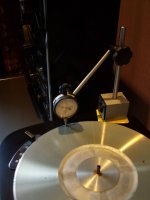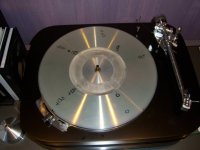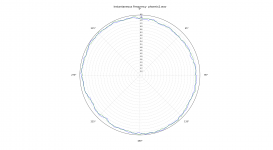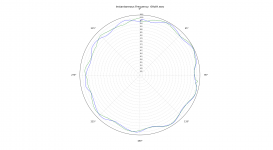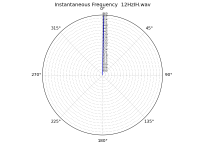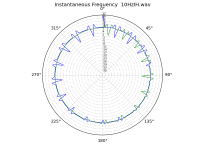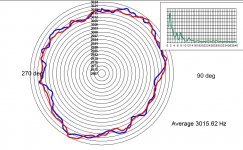Scott, some changes I did for myself to make it easier to tweak things:
Code:
filter_freq_def = "60"
sec_per_rev_def = "1.8"
Hz_per_tick_def = "3" #3 Hz per radial tick with 20 ticks
stereo_channel_def = "0" #left
#end edit
try:
input = raw_input
except NameError:
pass
_FILE = input('Enter a .wav file (no quotes and needs to be >= sec/rev*2.): ') #file needs to be >= sec_per_rev*2
stereo_channel = input('If stereo, 0 = left, 1 = right [' + stereo_channel_def + ']: ')
if not stereo_channel:
stereo_channel = stereo_channel_def
filter_freq = input('Filter frequency (Hz) [' + filter_freq_def + ']: ')
if not filter_freq:
filter_freq = filter_freq_def
sec_per_rev = input('Seconds per revolution [' + sec_per_rev_def + ']: ')
if not sec_per_rev:
sec_per_rev = sec_per_rev_def
Hz_per_tick = input('Hz per tick [' + Hz_per_tick_def + ']: ')
if not Hz_per_tick:
Hz_per_tick = Hz_per_tick_def
stereo_channel = int(stereo_channel)
filter_freq = float(filter_freq)
sec_per_rev = float(sec_per_rev)
Hz_per_tick = float(Hz_per_tick)
Code:
if np.size(y[1][0]) == 2:
sig = y[1][:,stereo_channel][0:int(Fs*(sec_per_rev*2))] #Grab sec/rev*2 sec of a stereo file from the first (left?) channel
else:
sig = y[1][0:int(Fs*(sec_per_rev*2))] #mono fileSure - I'd be happy to. But the .zip file won't extract for me says it's empty (so prob corrupt?).......... kindly post again please, or use Dropbox or similar for the raw file ?LD, would you consider processing the attached file 12.zip as 12.wav and see what you get? Any obvious conclusions to draw from my circular plot (resonances, bumps, whatever)?
Thnks,
R.
Thx LD
Here is another one this time with 1khz at 'Normpegel' whatever that means (odB?) from german Analogue Audio Association Test LP.
This time pitch is off too, but downwards, so one might conclude indeed the testrecords being unreliable not my platterspeed.
So, what problems can you spot looking at that plot?
This time pitch is off too, but downwards, so one might conclude indeed the testrecords being unreliable not my platterspeed.
So, what problems can you spot looking at that plot?
Attachments
Scott, some changes I did for myself to make it easier to tweak things:
Prompting the user for all the settings is a good idea. I would eventually need to work in the padding of the input since some files still catch the settling tail of the IIR filter. The initialization of the linear phase filter is built in and I haven't figured out all the subtleties but padding and un-padding is just simpler.
Reworking the plot canvas to display all the info and spectrum will be some work (much just fiddling with coordinates). Right now the object placement commands expect polar coordinates so I will create a cartesian piece for the rest of the stuff.
Again much thanks for your inputs.
This time pitch is off too, but downwards, so one might conclude indeed the testrecords being unreliable not my platterspeed.
It is good to remember that these tracks were often just there for amplitude calibration or wow and flutter measurement where the absolute frequency was not that important. There remains the option to actually count a revolution of cycles (there must be somebody out there crazy enough).
EDIT - Those USB scopes are good enough that one could probably take a fine needle and raise a burr on two consecutive bands and do it in software. I know there are folks that use a microscope and needle to remove skips and bad pops. CRAZY!
Last edited:
View attachment 637037
This is how I checked the platter flatness of my Lenco. And the result -
View attachment 637038
I obtained another platter which, whilst not perfect, was better than this one.
That's the right way to do it. IIRC my father left me one of those, I just need to find it.
Last tweak:
Code:
sec_per_rev_def = "A"
Code:
sec_per_rev_in = input('Seconds per revolution \r\n A = 33, B = 45, C = 78 \r\n Or enter time (s) [' + sec_per_rev_def + ']: ')
if not sec_per_rev_in:
sec_per_rev_in = sec_per_rev_def
try:
float(sec_per_rev_in)
sec_per_rev = sec_per_rev_in
except ValueError:
if sec_per_rev_in.lower() == "a":
sec_per_rev = "1.8"
elif sec_per_rev_in.lower() == "b":
sec_per_rev = "1.333"
elif sec_per_rev_in.lower() == "c":
sec_per_rev = ".766"Ok, now i get it. Of course the scratch has to be exactly radial...
Right, but if one makes the platter synchronizing pulse you can extract the actual number of cycles and create a correction factor. 3kHz is exactly 5400 cycles in one revolution at 33 1/3 RPM so simple counting gets you to ~.02%.
I've played around further.
This time with the tonearm-cartridge-resonance test from the Image-Hifi Test LP.
Scott, it seems your script can't lock on some test tones (the resonance of my arm-cart combo is around 10Hz).
10Hz sounds and looks wobbly, 12Hz & 6Hz sound reasonably well.
Only now I see that in the 10Hz the script locked on the Resonance-F, not on the 1kHz-tone...
This time with the tonearm-cartridge-resonance test from the Image-Hifi Test LP.
Scott, it seems your script can't lock on some test tones (the resonance of my arm-cart combo is around 10Hz).
10Hz sounds and looks wobbly, 12Hz & 6Hz sound reasonably well.
Only now I see that in the 10Hz the script locked on the Resonance-F, not on the 1kHz-tone...
Attachments
OK, got the file this time, thanks.LD, would you consider processing the attached file 12.zip as 12.wav and see what you get? Any obvious conclusions to draw from my circular plot (resonances, bumps, whatever)?
Thnks,
R.
Here's the polar plot, which is similar in form to yours but includes the inset spectrum which might provide some pointers.
It's unusual in shape in that there appears to be a strong near 2x rev component. I'd assume most of the remaining quasi-random content is from the cart-arm system, perhaps with resonances c 8Hz and 12Hz.......?
Without knowing the drive system, it's tough to comment further, other than it's unusual and a suitable case for treatment perhaps ............
HTH!
Attachments
Thanks a lot, LD,
I guess it is due to a bad Test-LP. In #626 I posted another example of a different Test-LP, looks more sane (but not perfect).
The arm-cart-resonance is around 10Hz, and my phono stage seems tp ṕick some hum.
I suspect my deck to have a minor fault, because it needs 2,5 seconds to lock on to the PLL on startup, yet the player is rated at rotating a 18Kg-Platter (I have the normal one at around 6 Kg).
quote from vintageknob.org:
I guess it is due to a bad Test-LP. In #626 I posted another example of a different Test-LP, looks more sane (but not perfect).
The arm-cart-resonance is around 10Hz, and my phono stage seems tp ṕick some hum.
I suspect my deck to have a minor fault, because it needs 2,5 seconds to lock on to the PLL on startup, yet the player is rated at rotating a 18Kg-Platter (I have the normal one at around 6 Kg).
quote from vintageknob.org:
Motor : DC 4-phase 8-pole
bi-directional servo
Platter : 37,4cm / 5,8kg
anodized
Inertia moment : 1,2t / cm2
Start up : 2kg / cm
Electronic braking : with YOP-1 ext. power-supply
Wow & flutter : 0,005% (FG measured)
S/N ratio : 85dB (DIN-B)
Attachments
You'll see that several odd things appear to have happened: the 0 deg file speed is significantly slower than the 90 deg file, and the eccentricity has moved by nearer 180 deg than 90 deg.............
Any ideas what else might have happened between recording the 2 test files ?
LD
The truth beckons!
Whilst I use the KAB Strobe Disc to set the TT speed for normal listening, when carrying out investigative work I resort to the PlatterSpeed app to check the speed and note excessive Wow and Flutter. This clearly is not accurate enough although to be fair I am trying to set the speed using a moving target. Further, I do find it difficult to centre test records certainly to the accuracy we are looking for. So a combination of the record being centred slightly differently and me adjusting the TT speed to compensate are probably the reasons for the variations between traces.
I have just repeated a speed test but this time set the Lenco’s speed using a frequency counter. The result is below and the sound file is attached if required (no position pulse recorded).
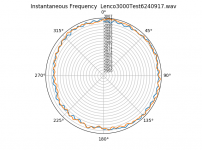
View attachment Lenco3000Test6240917.zip
From the polar plot is can be seen that the frequency is, between 315° and 170°, 3001Hz. It decreases by 6Hz @270°; this could be due to the test record but also the platter flatness (or lack of!)
Otherwise, the spectrum looks very like a Lenco - that characteristic ~ 25Hz variation from the motor shaft. It looks quite healthy, though - I've seen far worse Lenco's by measurement, and I've never seen one without the ~25Hz content. I'd assume the ~9Hz content to be cart/arm resonance, but can't remember how many poles the Lenco motor has (4 I think?).
LD
I agree with your observations, the 25Hz is motor shaft rotation although my Lenco has display significantly reduces amounts as can be seen here. I think my motor needs a service!
The 9Hz is arm/cart resonance and the motor is a 4 pole one. And thanks for the comments about the TT’s health. It was by carrying out speed accuracy testing that I gained a better understanding of the Lenco’s drive system and hence was able to tune it up to give the performance it now has; it was somewhat worse when I first started!
Question: Is there a quick way to centre records or is it an iterative process?
I've played around further.
This time with the tonearm-cartridge-resonance test from the Image-Hifi Test LP.
Scott, it seems your script can't lock on some test tones (the resonance of my arm-cart combo is around 10Hz).
10Hz sounds and looks wobbly, 12Hz & 6Hz sound reasonably well.
Only now I see that in the 10Hz the script locked on the Resonance-F, not on the 1kHz-tone...
Could you post the files, typically tonearm cartridge resonance tracks have no 1kHz only the low frequency tones which are far outside the parameters that we are checking. The fact that you actually got a 10Hz circle amazes me.
- Status
- This old topic is closed. If you want to reopen this topic, contact a moderator using the "Report Post" button.
- Home
- Source & Line
- Analogue Source
- Turntable speed stabilty
